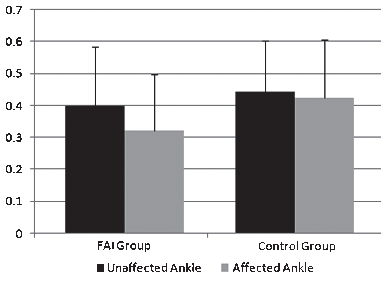|
PRACTICAL
SIGNIFICANCE
Peroneal
muscle
inhibition
is
present
in
patients
suffering
from
functional
ankle
instability,
but this
weakness
is not
related
to
dynamic
ankle
instability.
Additionally,
interventions
aimed at
minimizing
muscle
inhibition
may not
assist
in
protecting
the
ankle
from
further
episodes
of
instability.
STUDY
BACKGROUND
Functional
ankle
instability
(FAI)
may be
prevalent
in as
many as
40% of
patients
following
an acute
lateral
ankle
sprain.
Diminished
afference
resulting
from
damaged
mechanoreceptors
after an
ankle
sprain
may lead
to
reflex
inhibition
of
surrounding
joint
musculature.
This
weakness,
referred
to as
arthrogenic
muscle
inhibition
(AMI),
maybe
the
underlying
cause of
FAI.
Incomplete
peroneal
activation
could
prevent
adequate
control
of the
ankle
joint
leading
to
repeated
episodes
of
instability.
OBJECTIVE
To
establish
if
peroneal
muscle
inhibition
is
related
to
diminished
dynamic
ankle
restraint
characteristics
in
patients
with
FAI.
DESIGN
AND
SETTING
A 2 x 2
factorial
design
was used
to
compare
limbs
(affected
and
unaffected)
between
groups
(FAI and
control).
This
study
was
conducted
in the
Neuromuscular
Research
Laboratory
at The
University
of
Michigan.
SUBJECTS
Twenty-one
(18F,
3M)
subjects
with
unilateral
FAI (Age
= 21± 2
yrs,
Height =
171 ± 7
cm,
Weight =
65 ± 9
kg) and
21 (18F,
3M)
matched
controls
(Age =
21± 3
yrs,
Height =
169 ± 9
cm,
Weight =
64 ± 10
kg)
volunteered
to
participate.
MEASUREMENTS
To
establish
the
presence
of
muscle
inhibition,
bilateral
peroneal
H:M
recruitment
curves
were
obtained
via
stimulation
of the
sciatic
nerve
just
prior to
its
bifurcation
into the
tibial
and
common
peroneal
nerves
in the
popliteal
fossa.
The
maximum
H reflex
and M
wave
were
extracted
and the
H:M
ratios
were
calculated.
To
gather
dynamic
response
characteristics,
subjects
were
asked to
walk the
length
of an
8.5 m
runway
25
times.
A trap
door
mechanism
was
released
upon
heel
contact
of six
randomly
assigned
trials
for each
leg
(Figure
1).
Subjects
walked
to the
beat of
a
metronome
and wore
goggles
which
blocked
their
inferior
field of
view.
An
electromagnetic
switch
marked
the
release
of the
trap
door.
Custom
software,
verified
by
visual
inspection,
identified
the
peroneal
muscle
onset,
which
was used
to
calculate
reaction
time and
normalized
RMS EMG
for the
100 ms
following
onset of
muscle
activity.
RESULTS
FAI
subjects
had
smaller
peroneal
H:M
ratios
in their
pathological
ankle
(.323±.161)
compared
to their
nonpathological
ankle
(.399±.185)
(P=.036),
while no
differences
were
noted
between
the
ankles
of the
controls
(.442±.176
and
.425±.180)
(Figure
2).
FAI
subjects
also
exhibited
significantly
higher
latency
and
lower
EMG in
their
pathological
ankle
(Lat =
106.6±48.7;
EMG
=1.7±1.3)
compared
to their
uninjured
ankle
(Lat =
74.3±23.3;
EMG =
3.3±3.1)
(P<0.001),
while no
differences
between
legs
were
noted
for
controls
(P>0.05).
No
significant
correlations
were
found
between
the
peroneal
H:M
ratio
and the
measures
of
dynamic
instability
(P>0.05).
CONCLUSIONS
Our data
suggest
that
peroneal
muscle
inhibition
is
present
in
patients
with
functional
ankle
instability.
No
relationship
could be
established
between
the
lingering
inhibition
and
dynamic
ankle
function.
Thus,
interventions
focused
on
reversing
peroneal
muscle
inhibition
may not
assist
in
protecting
the
ankle
from
further
episodes
of
instability.

Figure
1.
Ankle
Inversion
Runway

Figure
2.
Peroneal
H:M
ratios
for the
FAI and
Control
groups.
Funded
by NFL
Charities
|
Publication
and
Presentation
List:
-
Palmieri-Smith
RM,
Hopkins
JT.
Dynamic
Instability
in
Patients
with
Functional
Ankle
Instability.
2008.
National
Athletic
Trainers’
Association
Annual
Meeting
&
Clinical
Symposium
St.
Louis,
MO.
-
Palmieri-Smith
RM,
Hopkins
JT.
Neuromuscular
Dysfunction
in
Persons
with
Functional
Ankle
Instability.
2008.
2nd
World
Congress
on
Sports
Injury
Prevention,
Tromso,
Norway.
|
|
|
|

Riann Palmieri-Smith, PhD, ATC
Principal Investigator
|
Dr. Palmieri-Smith is an Assistant Professor in Athletic Training, Movement Science, and Orthopaedics at the University of Michigan, as well as the director of the Neuromuscular Research Laboratory and co-director of the Human Neuromechanics Laboratory and Injury Biomechanics Laboratory at U of M. Additionally, Palmieri-Smith serves as a Section Editor for Sports Health: A Multidisciplinary Approach and is a guest reviewer for 15 other peer-reviewed journals.
Riann Palmieri-Smith, PhD, ATC
University of Michigan
3060D CCRB 401 Washtenaw Avenue
Ann Arbor, MI 48109
Phone: 734-615-3154
Fax: 734-936-1925
riannp@umich.edu |
| |
|
|

J. Ty Hopkins, PhD, ATC, FACSM
Principal Investigator
|
Ty Hopkins is currently an associate professor at Brigham Young University, where he coordinates the graduate programs in athletic training and physical medicine and rehabilitation. Dr. Hopkins graduated from Brigham Young University with a BS in athletic training. The focus of Dr. Hopkins’ research centers on prevention and rehabilitation of lower extremity joint injury. He serves as a section editor for the Journal of Athletic Training, and he serves as a reviewer with many other journals and granting agencies.
J. Ty Hopkins, PhD, ATC, FACSM
Brigham Young University
Department of Exercise Sciences
Provo, UT 84602
Phone: (801) 422-1573
Fax: (801) 422-0555
tyhopkins@byu.edu |
|
|
This
Grant
Information
Summary
may be
downloaded
in a
2-page
pdf file
from
http://www.natafoundation.org/pdfs/08PalmieriSmithHopkinsGrantSummary.pdf |
Back to
December
17, 2008
eBlast
Newsletter
Send e-mail
to johno@nata.org with questions
or
comments
about this web site. |


